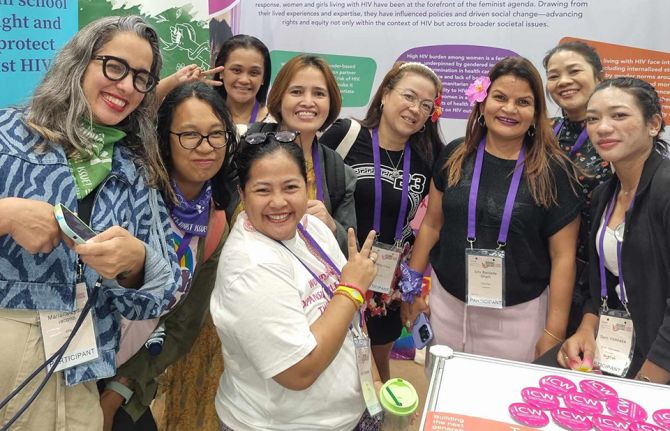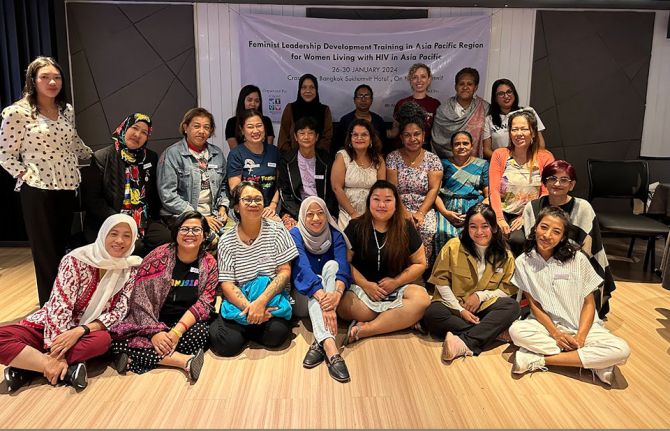
Feature Story
Violence against women and HIV
10 November 2009
10 November 2009 10 November 2009
Women living with HIV are more likely to have experienced violence, and women who have experienced violence are more likely to have HIV infection. Credit: UNAIDS/P.Virot
Numerous studies from around the globe confirm the links between violence against women and HIV. These studies show that women living with HIV are more likely to have experienced violence, and that, women who have experienced violence are more likely to have HIV infection.
From 27-29 October the World Health Organization (WHO), on behalf of the UNAIDS family, convened a working group of experts and practitioners to review evidence around the links between violence against women and HIV, as well as programmatic interventions and strategies which address the intersections of violence and HIV. The aim of the meeting was to make policy and programmatic recommendations for national and international AIDS programmes as well as to develop an agenda for future programme development, evaluation and research efforts based on a review of evidence from different interventions.
The meeting was part of UNAIDS efforts to operationalize the Joint Action for Results: the UNAIDS Outcome Framework, which includes violence against women and girls as one of its nine priority areas.
Violence and HIV
According to a 2006 report by United Nations Secretary-General one out of every three women around the world has been beaten, coerced into sex, or otherwise abused in her lifetime, usually by someone known to her.
Long-term interventions which address structural factors, gender inequalities and harmful gender norms, are essential if one is to reduce violence against women and HIV.
Kristan Schoultz, Director, Global Coalition on Women and AIDS
Violence and the threat of violence dramatically increase the vulnerability of women and girls to HIV by making it difficult or impossible for women to abstain from sex, to get their partners to be faithful, or to use a condom. The risk of HIV transmission increases during violent or forced-sex situations as the abrasions caused through forced penetration can facilitate entry of the virus.
Violence, or fear of violence, also makes it difficult for women and girls to disclose their HIV status and access essential HIV prevention, care, and treatment services. Women may also avoid HIV testing due to fears of violence and abandonment in a resulting discovery of HIV-positive status.
As noted by Dr. Claudia Garcia-Moreno, from WHO’s Department of Reproductive Heatlh and Research and Coordinator of the WHO Multi-country Study on women's health and domestic violence, “Violence against women is a fundamental violation of human rights and is often fueled by longstanding social and cultural norms that reinforce its acceptability in society – by both men and women. But there are concrete steps we can take in the AIDS and development responses to address violence, thereby dramatically improving women’s health and quality of life”.
Behaviour and societal change
According to participants at the consultation, policies and programmes addressing gender inequality and gender-based violence will help achieve universal targets to HIV prevention, treatment and care. Investment in responses in these areas is an essential part of HIV programming.
“Long-term interventions which address structural factors, gender inequalities and harmful gender norms, are essential if one is to reduce violence against women and HIV,” said Kristan Schoultz, Director of the Global Coalition on Women and AIDS. “At the same time there is also a need to move forward urgently to achieve shorter-term gains such as enhanced voluntary counselling and testing services and the provision of comprehensive post-rape care that addresses the psychological and physical health needs of sexual violence survivors”.
Participants believe that a “mosaic” of action addressing both long-term and short-term needs related to violence and HIV has the potential to have an impact upon not only MDG 6 (HIV), but all the health MDGs, including reduction of maternal mortality and achievement of sexual and reproductive health and rights; in addition, this approach is at the heart of MDG 3 (gender equality and empowerment of women) and MDG1 (poverty reduction).
The outcomes and recommendations from the meeting will feed into ongoing national and global advocacy efforts such as those of the Global Coalition on Women and AIDS, the UN Secretary General's Campaign for the Elimination of Violence against Women, and the Africa-Wide Campaign for the elimination of Violence against Women. Recommendations will also assist national AIDS authorities to better address the intersections between HIV and violence in national programming.
Violence against women and HIV
Cosponsors:
Partners:
Global Coalition on Women and AIDS (GCWA)
Feature stories:
WHO report on the health of women: AIDS leading cause of death globally in women of reproductive age (09 November 2009)
Empowering women to protect themselves: Promoting the female condom in Zimbabwe (29 October 2009)
UNAIDS partners in new Clinton Global Initiative to address sexual violence against girls (25 September 2009)
New report shows Asian migrant women in the Arab states have heightened vulnerability to HIV (10 March 2009)
Commission on the Status of Women opens with call for action to achieve universal access and gender equality (02 March 2009)
Challenging violence against women a key task for newly launched Caribbean Coalition on Women, Girls and AIDS (06 March 2009)
Highlighting sexual violence on International Women’s Day (05 March 2009)
Publications:
Women and Health: Today’s Evidence, Tomorrow’s Agenda
UNAIDS Outcome framework 2009-11 (pdf, 396 Kb.)
2008 Delegates Guide to Women and AIDS: All Women, All Rights (pdf, 506 Kb.)
An Analysis of the Gender Policies of the Three Major AIDS Financing Institutions: The Global Fund to Fight AIDS, Tuberculosis and Malaria, the World Bank and the President’s Emergency Plan for AIDS Relief (pdf, 150 Kb.)
Joint action for results: UNAIDS outcome framework, 2009 – 2011 (pdf, 322 Kb.)



